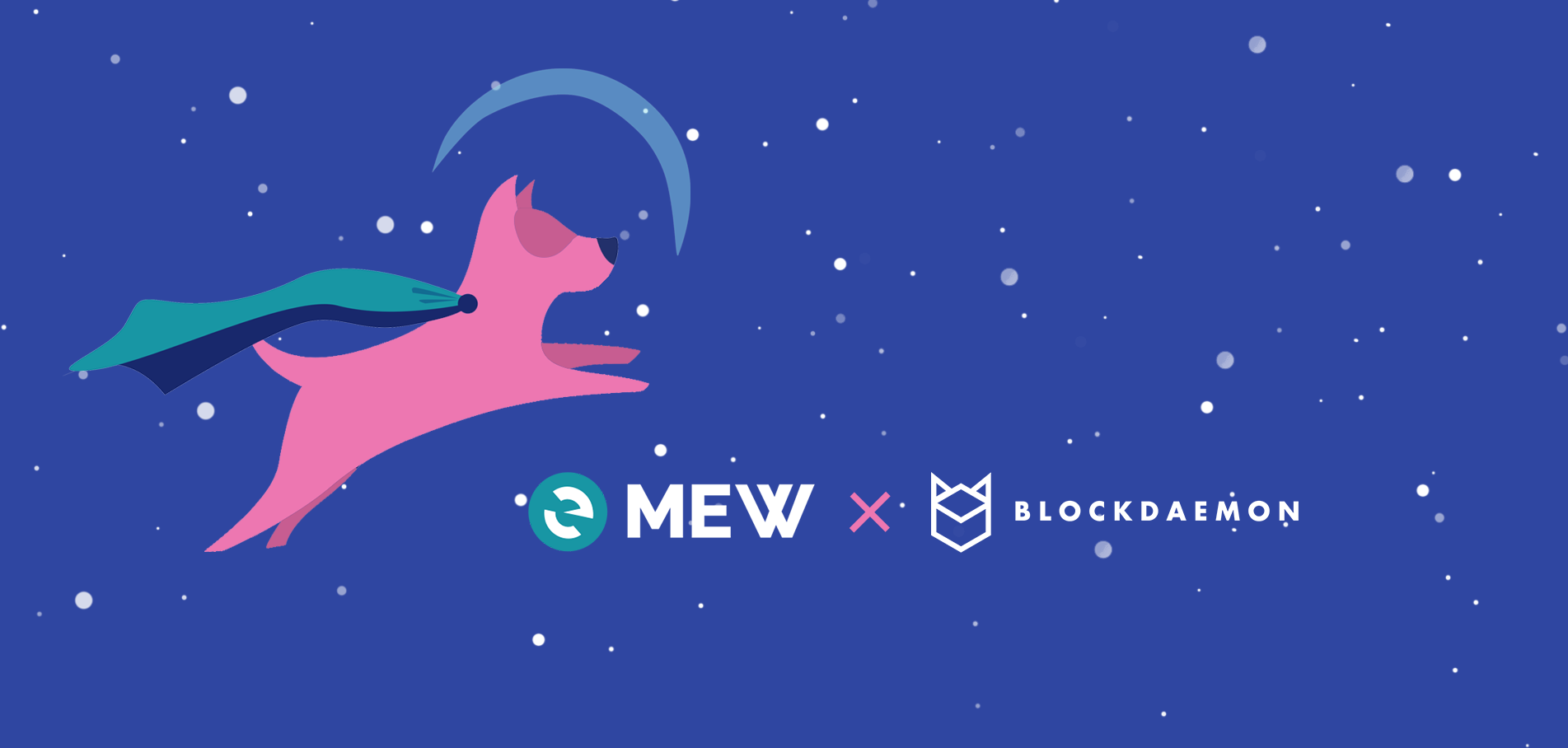All cryptocurrencies are based on blockchains – decentralized networks that are maintained by active participants who validate the transactions, making sure the blockchain stays secure and active. There are two main methods of blockchain validation: proof-of-work, the original consensus model used by Bitcoin and the current Ethereum network, and proof-of-stake, to which Ethereum is moving.
Proof-of-work requires significant computer power and energy expenditure, while proof-of-stake relies on participants who use their crypto coins to secure the network.
MEW wallet app now offers staking on Eth2 via Staked and Lido, and staking on SKALE network supported by Blockdaemon, a leading blockchain infrastructure provider and an expert in proof-of-stake validator maintenance. We asked Blockdaemon to go over the rewards and risks associated with staking cryptocurrency for our MEWtopia readers - enjoy!

Proof-of-stake is a remarkable advancement in blockchain technology. The concept of staking has been around since 2012. However, it is only relatively recently that viable proof-of-stake projects have entered into the crypto zeitgeist. Many projects offer greater scalability and utility, while matching Bitcoin’s security guarantees – all at a fraction of the proof-of-work energy cost.
It is no surprise then that proof-of-stake represents a sizable chunk of today’s crypto market.
Even Ethereum, the world’s second largest blockchain by market capitalization, is soon transitioning from proof-of-work to proof-of-stake. The result, we expect, will be the largest mass-adoption event of DeFi and proof-of-stake that the industry has ever seen. Ethereum 2.0 will see millions of newcomers flood into proof-of-stake in the coming months and years.
However, proof-of-stake is not without its pitfalls. The technology is relatively new. Many stake-based blockchains are still finding their feet. We have seen block production grinding to a halt on some networks. Developers are hard at work building out functionality. It’s undeniable, therefore, that staking can present some risks.
Proof-of-stake: Rights & Responsibilities
Proof-of-stake networks are secured by its community members. The amount of tokens you own equals your impact in the network.
Token holders are effectively citizens of these digital democracies. By holding a proof-of-stake coin, you are granted a set of rights within the system. Unlike in societies governed by centralized legislation, these rights are baked into the code, rather than written as law.
Regardless, these rights are inalienable. They can include, but are not limited to, the following:
- The right to work (i.e. participate in block production)
- The right to vote (i.e. vote on network improvements)
- The right to trade (i.e. participating in buying, selling and using DeFi)
These rights are counterbalanced by both risks and rewards.
Staking Rewards & Risks
Staking is the heartbeat of proof-of-stake networks. The rewards attract many participants to earn yield through delegation. No expensive mining equipment is required, and anyone can participate. Rewards are generated on-chain.
The great responsibilities imbued into proof-of-stake also come with risks. No one said being your own bank would be easy. Risks exist both at the protocol level, where a smart contract failure or validator errors can lead to loss of funds, and at the human level, where best security practices apply as elsewhere in crypto.
Slashing
Slashing is a common penalty across some proof-of-stake networks. It is a penalty imposed on inactive or delinquent validators. Slashing can happen to anyone, even Blockdaemon. However, not every blockchain has a slashing mechanic. For example, Cardano is a popular chain which doesn’t use slashing. Slashing is commonly seen in Polkadot and Ethereum 2.0.
Ethereum 2.0 (ETH2) Slashing
Slashing’s goal is to make it prohibitively expensive to attack Eth2, and to penalize validators for not performing their duties well in consensus.
A validator has a minimum balance of 32 Ether. (Staking on Eth2 is possible both with a full validator commitment of 32 ETH and with smaller amounts, via platforms like Lido.) Penalties and rewards are reflected in this balance over time. Penalties and rewards are issued roughly every six minutes, which is an epoch of time in Eth2. Within each epoch, the network judges a validator’s actions and issues rewards or penalties in line with this.
Slashing penalties can range from around 0.5 Ether to a validator’s entire stake. Honest validators cannot be slashed by other validators. Network attacks which are coordinated result in large penalties across actors in the network, whereas single, uncorrelated slashing incidents are punished less harshly.
Theft
Theft is a common risk that's pervasive throughout the crypto industry. Proof-of-stake is no exception. Staking often requires delegation. Delegation means giving your right to mint a block to someone else. This right confers rewards, issued by the blockchain itself. Delegation is useful where stakers lack the time, resources or knowledge necessary to participate. It also opens the benefits of staking to a much wider audience.
Custodial vs. Non-Custodial Staking
Delegation can be custodial or non-custodial. Non-custodial delegation is where you only transfer the right to mint a block to someone else. No money is transferred on-chain. Simply put, you retain full control over your own funds at all times. This works well on many networks, where rewards are distributed at a protocol level.
SKALE is an example of a network where you retain full control of your stake. You simply delegate staking rights. SKALE staking via the MEW wallet app leverages this mechanic. By staking your SKL tokens via the app, you are delegating tokens to Blockdaemon’s validators. Blockdaemon helps you earn token rewards without ever holding them.
Custodial staking is where you grant your right to mint a block and funds to someone else. Ethereum 2.0 is an example of such a blockchain. This is often considered pure proof-of-stake, as 32 Ether is required. By delegating this to a validator, you’re trusting them with your funds.
Tezos distributes staking rewards through the hands of their validators. These validators, known as bakers, are responsible for distributing rewards to their delegators. Unfortunately, this runs the risk of validators keeping rewards. While this ruins their reputation, it has cost some delegators dearly.
Off-chain risks take advantage of human vulnerabilities. Certain scammers offer staking wallets which look real, yet are a way of harvesting private keys. In such situations, the usual best security practices, such as never entering your wallet keys on a website, help avoid loss of staked assets.
Lock-Up
Token lock-up is common across popular proof-of-stake chains. Token lockup is a risk because of the opportunity cost involved. You may be unable to liquidate your position. You may want to opt into a compelling DeFi opportunity. A market crash could happen, yet your tokens would remain inaccessible. Lock-ups can range from days (with Solana) to months or longer (with Ethereum 2.0), depending on the protocol.
Fortunately, some solutions offer liquidity for locked-up tokens. Lido offers a compelling liquidity solution for Ethereum 2.0 and Solana. Meanwhile, Acala (a parachain of Kusama) offers liquidity across Polkadot and Kusama. This liquidity allows users to participate in DeFi, without sacrificing their staking rewards Acala achieves this with the help of Blockdaemon. Liquidity is the lifeblood of DeFi, making these solutions extremely useful.
MEW works with Blockdaemon to protect users
Ever since Bitcoin’s inception, those in the crypto industry have raised concerns over its ever-increasing energy usage. This criticism stood against a backdrop of increasing global concern around climate change. Proof-of-stake offers a compelling alternative.
Proof-of-stake is radically egalitarian. As a proof-of-stake participant, you can:
- Help decide who mints blocks in the chain (i.e. delegation on Ethereum 2.0)
- Vote on governance proposals (i.e. voting on Cardano)
- Support innovative projects (i.e. parachain auctions on Polkadot)
These responsibilities bring rewards. Active participation in staking, voting, and supporting innovative projects can often be rewarded by the native crypto token. However, these opportunities also bring risk.
That’s why MEW works with trusted partners like Blockdaemon to help protect users’ assets. Blockdaemon hosts over 10,000 nodes for some of the biggest blockchain companies and is 100% insured.
SKALE staking in MEW wallet app iOS only takes a few steps.
Download the app if you don’t already have it installed.
Buy ETH and/or swap for SKL tokens.
Go to the Earn tab to start staking SKL!

